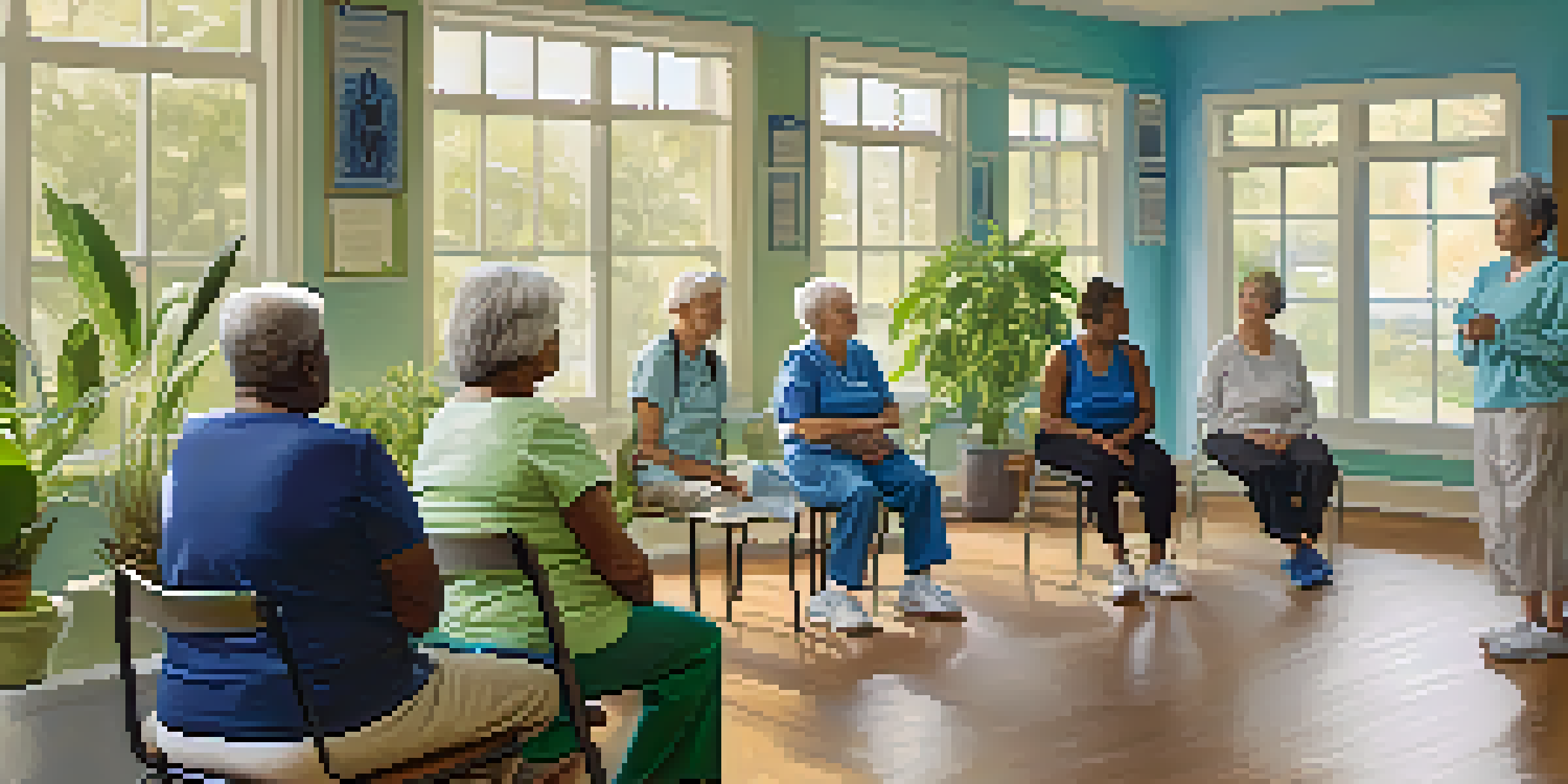The Importance of Pulmonary Rehabilitation for COPD Patients

Understanding COPD and Its Challenges for Patients
Chronic Obstructive Pulmonary Disease (COPD) affects millions worldwide, making breathing a daily challenge. Patients often experience symptoms like chronic cough, wheezing, and shortness of breath, which can significantly impact their quality of life. These challenges not only affect physical health but can also lead to emotional struggles such as anxiety and depression.
Breathing is the greatest pleasure in life.
The progressive nature of COPD means that symptoms can worsen over time, making it crucial for patients to seek effective management strategies. Without proper intervention, daily tasks can become daunting, pushing many to limit their activities. This limitation can create a cycle of decreased fitness and increased breathlessness, further complicating their condition.
This is where pulmonary rehabilitation steps in as a beacon of hope. By understanding the complexities of COPD, we can better appreciate the importance of tailored rehabilitation programs designed to empower patients and improve their overall well-being.
What Is Pulmonary Rehabilitation?
Pulmonary rehabilitation is a comprehensive program that combines physical exercise, education, and support to help individuals manage their COPD. It’s not a one-size-fits-all approach; instead, it’s tailored to the specific needs and abilities of each patient. The goal is to improve physical function, enhance quality of life, and teach patients how to manage their symptoms effectively.

Typically, these programs include supervised exercise training, nutritional counseling, and education about the disease and its management. By participating in structured exercise, patients can strengthen their respiratory muscles and improve their endurance. This newfound strength often translates into a greater ability to perform daily tasks without excessive fatigue.
COPD Challenges Impact Quality of Life
Chronic Obstructive Pulmonary Disease significantly affects patients' physical and emotional well-being, making breathing and daily tasks increasingly difficult.
Moreover, pulmonary rehabilitation also focuses on breathing techniques and energy conservation strategies, which are invaluable for those living with COPD. By integrating these elements, the program empowers patients to take charge of their health and fosters a sense of community among participants.
The Physical Benefits of Pulmonary Rehabilitation
One of the most significant benefits of pulmonary rehabilitation is the enhancement of physical fitness. Regular exercise, tailored to each patient's capability, helps improve lung function and overall stamina. As patients engage in consistent physical activity, they often report feeling less breathless during daily activities, which can dramatically improve their quality of life.
The greatest weapon against stress is our ability to choose one thought over another.
In addition to better lung function, patients often experience improved muscle strength and flexibility. This is crucial, as many COPD patients may have decreased mobility due to fear of breathlessness. By gradually increasing their activity levels through rehabilitation, patients can build their confidence and break the cycle of inactivity.
Furthermore, the physical progress achieved in rehabilitation can lead to fewer hospitalizations and emergency visits. This means not only a better experience for patients but also a reduction in healthcare costs, making pulmonary rehabilitation beneficial for individuals and the healthcare system alike.
Emotional and Psychological Benefits
Living with a chronic illness like COPD can take a toll on mental health. Patients often feel isolated or overwhelmed by their condition, which can lead to anxiety and depression. Pulmonary rehabilitation addresses these emotional challenges by providing support and education, fostering a sense of community among participants.
The group settings often found in rehabilitation programs allow patients to share experiences, reducing feelings of isolation. Being part of a supportive community can be incredibly empowering, as individuals realize they are not alone in their struggles. This camaraderie contributes to improved mental well-being and resilience.
Pulmonary Rehabilitation Empowers Patients
Tailored pulmonary rehabilitation programs combine exercise, education, and support to help COPD patients manage their symptoms and enhance their quality of life.
Moreover, the education component of pulmonary rehabilitation helps patients understand their condition better, which can alleviate fears and uncertainties. Knowledge is power, and when patients feel informed about their health, they are more likely to adopt proactive strategies for managing their COPD.
Motivation and Goal Setting in Rehabilitation
Setting realistic goals is a vital part of the pulmonary rehabilitation process. Patients work closely with healthcare providers to establish personal health goals, whether that’s taking a walk without stopping or participating in social activities. Achieving these goals can significantly boost confidence and motivation, reinforcing the importance of perseverance.
Motivation often waxes and wanes, especially for those facing chronic health challenges. Rehabilitation programs provide ongoing support to help patients stay committed to their goals. This support can come in the form of regular check-ins, progress tracking, and encouragement from both healthcare providers and peers.
As patients witness their progress, whether through increased activity levels or reduced breathlessness, their motivation often grows. This positive reinforcement is crucial for long-term success, helping individuals not just to survive but to thrive despite their COPD.
The Role of Healthcare Providers in Rehabilitation
Healthcare providers play a pivotal role in guiding patients through pulmonary rehabilitation. They assess individual needs, create personalized plans, and monitor progress throughout the program. This tailored approach ensures that patients receive the right interventions at the right time, maximizing the benefits of rehabilitation.
In addition to physical training, healthcare providers also offer education about COPD management. This includes teaching patients about medication adherence, recognizing symptoms, and understanding when to seek medical help. Empowering patients with knowledge is essential for their long-term health and well-being.
Healthcare Providers Enhance Rehabilitation
Healthcare providers play a crucial role in pulmonary rehabilitation by creating personalized plans and fostering ongoing support to improve patient outcomes.
Moreover, ongoing support from healthcare providers fosters trust and encourages open communication. Patients who feel supported are more likely to engage actively in their rehabilitation, leading to better outcomes and a stronger commitment to their health journey.
The Future of Pulmonary Rehabilitation for COPD Patients
As we look to the future, the importance of pulmonary rehabilitation in COPD management will only continue to grow. With advancements in technology, we are seeing the emergence of tele-rehabilitation programs that offer patients flexibility and accessibility. This is particularly beneficial for those who may have difficulty traveling to traditional rehabilitation settings.
Ongoing research into the benefits and methods of pulmonary rehabilitation is also paving the way for more effective programs tailored to diverse patient needs. As our understanding of COPD deepens, we can anticipate more innovative approaches that enhance patient engagement and outcomes.

Ultimately, the aim is to make pulmonary rehabilitation an integral part of COPD management. By fostering a collaborative approach among patients, healthcare providers, and researchers, we can continue to improve the lives of those living with this challenging condition.